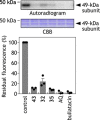Discovery of Bis-sulfonamides as Novel Inhibitors of Mitochondrial NADH-Quinone Oxidoreductase (Complex I)
- PMID: 36793437
- PMCID: PMC9923842
- DOI: 10.1021/acsmedchemlett.2c00504
Discovery of Bis-sulfonamides as Novel Inhibitors of Mitochondrial NADH-Quinone Oxidoreductase (Complex I)
Abstract
Mitochondrial oxidative phosphorylation (OXPHOS) is an essential cellular metabolic process that generates ATP. The enzymes involved in OXPHOS are considered to be promising druggable targets. Through screening of an in-house synthetic library with bovine heart submitochondrial particles, we identified a unique symmetric bis-sulfonamide, KPYC01112 (1) as an inhibitor targeting NADH-quinone oxidoreductase (complex I). Structural modifications of KPYC01112 (1) led to the discovery of the more potent inhibitors 32 and 35 possessing long alkyl chains (IC50 = 0.017 and 0.014 μM, respectively). A photoaffinity labeling experiment using a newly synthesized photoreactive bis-sulfonamide ([125I]-43) revealed that it binds to the 49-kDa, PSST, and ND1 subunits which make up the quinone-accessing cavity of complex I.
© 2023 American Chemical Society.
Conflict of interest statement
The authors declare no competing financial interest.
Figures






Similar articles
-
Fenpyroximate binds to the interface between PSST and 49 kDa subunits in mitochondrial NADH-ubiquinone oxidoreductase.Biochemistry. 2012 Mar 6;51(9):1953-63. doi: 10.1021/bi300047h. Epub 2012 Feb 27. Biochemistry. 2012. PMID: 22353032
-
Photoaffinity Labeling of Respiratory Complex I in Bovine Heart Submitochondrial Particles by Photoreactive [125I] amilorides.Bio Protoc. 2019 Sep 5;9(17):e3349. doi: 10.21769/BioProtoc.3349. eCollection 2019 Sep 5. Bio Protoc. 2019. PMID: 33654851 Free PMC article.
-
NADH-quinone oxidoreductase: PSST subunit couples electron transfer from iron-sulfur cluster N2 to quinone.Proc Natl Acad Sci U S A. 1999 Mar 30;96(7):4149-53. doi: 10.1073/pnas.96.7.4149. Proc Natl Acad Sci U S A. 1999. PMID: 10097178 Free PMC article.
-
Exploring the binding pocket of quinone/inhibitors in mitochondrial respiratory complex I by chemical biology approaches.Biosci Biotechnol Biochem. 2020 Jul;84(7):1322-1331. doi: 10.1080/09168451.2020.1747974. Epub 2020 Apr 7. Biosci Biotechnol Biochem. 2020. PMID: 32264779 Review.
-
Iron-sulfur clusters/semiquinones in complex I.Biochim Biophys Acta. 1998 May 6;1364(2):186-206. doi: 10.1016/s0005-2728(98)00027-9. Biochim Biophys Acta. 1998. PMID: 9593887 Review.
References
LinkOut - more resources
Full Text Sources
Miscellaneous

